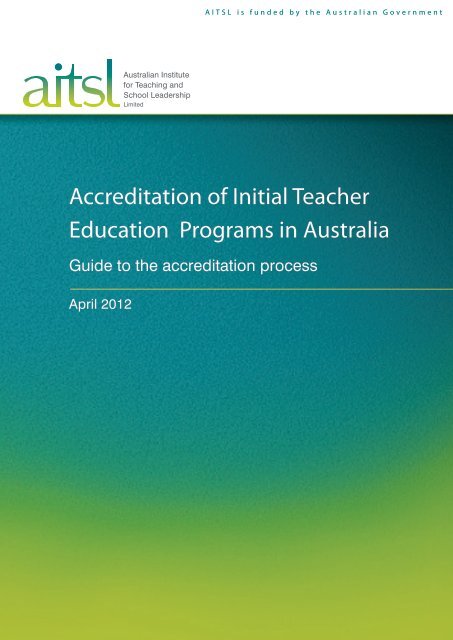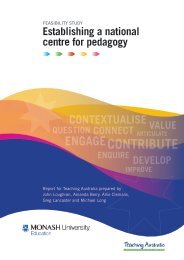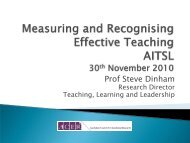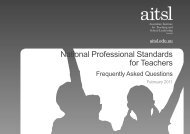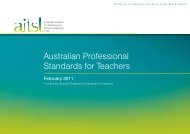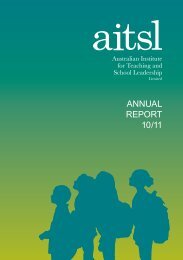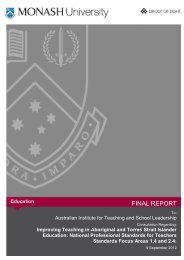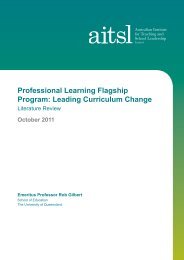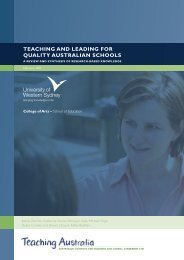Guide to the accreditation process - Australian Institute for Teaching ...
Guide to the accreditation process - Australian Institute for Teaching ...
Guide to the accreditation process - Australian Institute for Teaching ...
Create successful ePaper yourself
Turn your PDF publications into a flip-book with our unique Google optimized e-Paper software.
First published December 2011Reprinted with amendments April 2012© 2011 Education Services Australia as <strong>the</strong> legal entity <strong>for</strong> <strong>the</strong> Ministerial Council <strong>for</strong> Education, EarlyChildhood Development and Youth Affairs (MCEEDCYA).Education Services Australia, as <strong>the</strong> legal entity <strong>for</strong> <strong>the</strong> Ministerial Council <strong>for</strong> Education Early ChildhoodDevelopment and Youth Affairs (MCEECDYA) owns <strong>the</strong> copyright in this publication. This publication orany part of it may be used freely only <strong>for</strong> non-profit education purposes provided <strong>the</strong> source is clearlyacknowledged. The publication may not be sold or used <strong>for</strong> any o<strong>the</strong>r commercial purpose.O<strong>the</strong>r than as permitted above or by <strong>the</strong> Copyright Act 1968 (Commonwealth), no part of this publication maybe reproduced, s<strong>to</strong>red, published, per<strong>for</strong>med, communicated or adapted, regardless of <strong>the</strong> <strong>for</strong>m or means(electronic, pho<strong>to</strong>copying or o<strong>the</strong>rwise), without <strong>the</strong> prior written permission of <strong>the</strong> copyright owner.Address inquiries regarding copyright <strong>to</strong>:MCEECDYA Secretariat, PO Box 202, Carl<strong>to</strong>n South, VIC 3053, Australia.The <strong>Australian</strong> <strong>Institute</strong> <strong>for</strong> <strong>Teaching</strong> and School Leadership was <strong>for</strong>med <strong>to</strong> provide national leadership <strong>for</strong> <strong>the</strong>Commonwealth, state and terri<strong>to</strong>ry governments in promoting excellence in <strong>the</strong> profession of teaching andschool leadership with funding provided by <strong>the</strong> <strong>Australian</strong> Government.
Table of Contents1.0 Introduction 31.1 Background 31.2 Context - <strong>the</strong> purpose of <strong>accreditation</strong> 31.3 Accreditation or re-<strong>accreditation</strong> 52.0 Application <strong>for</strong> <strong>accreditation</strong> 52.1 Documentation 52.2 Key stages in <strong>the</strong> <strong>accreditation</strong> <strong>process</strong> 72.3 Program changes 82.4 Re-<strong>accreditation</strong> 92.5 Types of evidence 9TEMPLATESA Application cover sheet A1Application declaration <strong>for</strong>mA2B Graduate Teacher Standards mapping matrix B1C Program Standards mapping matrix C12
1. Introduction1.1 BackgroundIn April 2011 <strong>the</strong> Ministerial Council <strong>for</strong> Education, Early Childhood Development and Youth Affairs(MCEECDYA) endorsed standards and procedures <strong>for</strong> <strong>the</strong> <strong>accreditation</strong> of initial teacher educationprograms in Australia. For convenience initial teacher education programs will be referred <strong>to</strong> as‘programs’ in <strong>the</strong> remainder of this document.These standards and procedures, developed through consultation with <strong>the</strong> teaching profession,teacher educa<strong>to</strong>rs, employers of teachers, teacher regula<strong>to</strong>ry authorities, schools and <strong>the</strong>education community more broadly, are detailed in AITSL’s document entitled Accreditation ofInitial Teacher Education Programs in Australia: Standards and Procedures (April 2011) andreferred <strong>to</strong> in this document as ‘Standards and Procedures’.This <strong>Guide</strong> <strong>to</strong> <strong>the</strong> <strong>accreditation</strong> <strong>process</strong> (<strong>the</strong> ‘<strong>Guide</strong>’) <strong>for</strong>ms part of <strong>the</strong> supplementary materials asoutlined in <strong>the</strong> Standards and Procedures. It provides an overview of and advice on <strong>the</strong><strong>accreditation</strong> <strong>process</strong>, and relevant templates <strong>to</strong> be used by providers in <strong>the</strong>ir application. The<strong>Guide</strong> requires providers <strong>to</strong> map <strong>the</strong>ir programs against <strong>the</strong> National Professional Standards <strong>for</strong>Teachers at <strong>the</strong> Graduate career stage. This is <strong>to</strong> ensure that <strong>the</strong> Graduate career stage of <strong>the</strong>Standards is met and even exceeded by those seeking <strong>to</strong> become teachers. The types of evidencerequired <strong>to</strong> show how a program will or does meet <strong>the</strong> Graduate Teacher Standards and ProgramStandards will come mainly from existing documentation.This <strong>Guide</strong> is <strong>for</strong> <strong>the</strong> use of providers applying <strong>for</strong>:• initial <strong>accreditation</strong> of a new (proposed) program under <strong>the</strong> national approach• initial <strong>accreditation</strong> of existing programs (i.e. programs accredited under <strong>the</strong> state system thathave not yet been accredited under <strong>the</strong> national approach) OR• re-<strong>accreditation</strong> of a program that has previously been accredited under <strong>the</strong> nationalapproach.1.2 Context – <strong>the</strong> purpose of <strong>accreditation</strong>The <strong>accreditation</strong> of programs is a key element in improving initial teacher education and <strong>the</strong>re<strong>for</strong>eimproving teacher quality. The national approach <strong>to</strong> <strong>accreditation</strong> has two key objectives:• improving teacher quality through continuous improvement of initial teacher education, and• accountability of providers <strong>for</strong> <strong>the</strong>ir delivery of quality teacher education programs based ontransparent and rigorous standards and <strong>accreditation</strong> <strong>process</strong>es.Accreditation of programs is in<strong>for</strong>med by six principles:1. Continuous improvement: The <strong>accreditation</strong> <strong>process</strong> contributes <strong>to</strong> <strong>the</strong> improvement of <strong>the</strong>quality of initial teacher education and consequently of teaching and learning in Australia,providing a guarantee of graduate teacher quality and building public confidence in <strong>the</strong>profession. It will lead <strong>to</strong> change where per<strong>for</strong>mance needs improvement, and challengeeffective providers and programs <strong>to</strong> improve fur<strong>the</strong>r. The Standards and Procedures documentis regularly reviewed and improved.3
2. Outcomes focus: The <strong>accreditation</strong> <strong>process</strong> sets high standards <strong>for</strong> graduate outcomes, andfocuses on ensuring <strong>the</strong>se are met.3. Flexibility, diversity and innovation: National <strong>accreditation</strong> celebrates and encourages <strong>the</strong>capacity of providers <strong>to</strong> be innovative in <strong>the</strong> delivery of programs <strong>to</strong> meet <strong>the</strong> diverse needs ofstudents and <strong>the</strong> profession. Accordingly, teacher education providers may present anevidence-based case that an element or elements of <strong>the</strong>ir programs meet <strong>the</strong> intent of <strong>the</strong>Program Standards and that <strong>the</strong>ir graduates satisfy <strong>the</strong> Graduate Teacher Standards.4. Partnerships: National <strong>accreditation</strong> is built around partnerships involving sharedresponsibilities and obligations among teacher education providers, schools, teachers,employers, and teacher regula<strong>to</strong>ry authorities.5. Building on existing expertise: National <strong>accreditation</strong> adds value <strong>to</strong> and builds on <strong>the</strong>strengths of jurisdictional <strong>accreditation</strong> experience, and <strong>the</strong> considerable expertise that existsin <strong>Australian</strong> teacher education. It acknowledges <strong>the</strong> professional prerogatives of <strong>Australian</strong>universities.6. Evidence: The credibility of national <strong>accreditation</strong> is built on evidence-based practice andcontributes <strong>to</strong> <strong>the</strong> development of evidence through research about what works in qualityteacher education. This evidence in turn in<strong>for</strong>ms <strong>the</strong> development of <strong>accreditation</strong>, allowing it<strong>to</strong> focus on those things shown <strong>to</strong> be related <strong>to</strong> outcomes.Accreditation also serves <strong>the</strong> more practical purpose of ensuring that <strong>the</strong> academic qualificationsachieved by graduates of <strong>the</strong> relevant programs are au<strong>to</strong>matically accepted <strong>for</strong> <strong>the</strong> purposes ofteacher registration in all <strong>Australian</strong> jurisdictions 1 . Providers may offer non-accredited programs,but <strong>the</strong> qualifications of graduates of such programs may not be acceptable <strong>for</strong> teacher registrationpurposes.It is acknowledged that programs and/or <strong>the</strong> providers offering <strong>the</strong>se are also subject <strong>to</strong> severalo<strong>the</strong>r assessment <strong>process</strong>es. This includes internal <strong>accreditation</strong> of programs and <strong>the</strong> qualityassessment undertaken by <strong>the</strong> Tertiary Education Quality and Standards Agency (TEQSA).The national approach <strong>to</strong> <strong>accreditation</strong> of programs is intended <strong>to</strong> complement, not duplicate, <strong>the</strong>se<strong>process</strong>es. AITSL will seek <strong>to</strong> cooperate with both TEQSA and also <strong>the</strong> new <strong>Australian</strong> Children’sEducation and Care Quality Authority (ACECQA) in minimising duplications of <strong>accreditation</strong>activity.The <strong>accreditation</strong> <strong>process</strong> described in this document is clearly focused on <strong>accreditation</strong> ofindividual degree programs, is specific <strong>to</strong> teacher education and has a direct link <strong>to</strong> teacherregistration. Assessment of programs as part of this <strong>process</strong> is <strong>the</strong>re<strong>for</strong>e undertaken from <strong>the</strong> poin<strong>to</strong>f view of <strong>the</strong> program’s adequacy as professional preparation <strong>for</strong> registration as a teacher.1 Registration of individual graduates would still be subject <strong>to</strong> o<strong>the</strong>r requirements as set out by <strong>the</strong> relevant teacher regula<strong>to</strong>ry authority.4
Submitting <strong>the</strong> applicationApplications should be submitted with <strong>the</strong> declaration <strong>for</strong>m signed by <strong>the</strong> dean of education (oro<strong>the</strong>r appropriate person) <strong>to</strong> <strong>the</strong> relevant officer in <strong>the</strong> relevant jurisdictional teacher regula<strong>to</strong>ryauthority. (Contact details <strong>for</strong> <strong>the</strong> various authorities are available on <strong>the</strong> AITSL website).Applications will include <strong>the</strong> following documents:• completed Template A — Application <strong>for</strong> <strong>accreditation</strong> or re-<strong>accreditation</strong> of an initial teachereducation program: Application cover sheet and declaration <strong>for</strong>m• completed Template B — Graduate Teacher Standards mapping matrix• completed Template C — Program Standards mapping matrix• full program documentation that includes in<strong>for</strong>mation on all units. In most cases this will be<strong>the</strong> program documentation already prepared <strong>for</strong> <strong>the</strong> provider’s internal or external<strong>accreditation</strong> <strong>process</strong>es depending on <strong>the</strong> provider’s self-<strong>accreditation</strong> status• additional material that <strong>the</strong> provider believes constitutes evidence <strong>for</strong> <strong>the</strong> purposes ofdemonstrating that program standards are met. This <strong>Guide</strong> provides advice on what maycomprise such evidence.The <strong>for</strong>mat of <strong>the</strong> application is <strong>to</strong> be negotiated with <strong>the</strong> relevant teacher regula<strong>to</strong>ry authority.If more than one program is <strong>to</strong> be submitted <strong>for</strong> <strong>accreditation</strong>, a separate application should besubmitted <strong>for</strong> each program. However, closely related programs that contain a number of commonunits may more efficiently be considered as one program. If <strong>the</strong>re is uncertainty about whatconstitutes a separate program, providers should liaise with <strong>the</strong> jurisdictional teacher regula<strong>to</strong>ryauthority <strong>to</strong> determine whe<strong>the</strong>r separate applications will be needed. If separate applications arerequired and <strong>the</strong>se are considered by different panels, <strong>the</strong> teacher regula<strong>to</strong>ry authority will takesteps <strong>to</strong> ensure consistency across panels in advice relating <strong>to</strong> <strong>the</strong> common elements. It may bemore efficient <strong>to</strong> consider multiple programs from one provider at <strong>the</strong> same time. Again, in thiscase <strong>the</strong> provider should liaise with <strong>the</strong> jurisdictional teacher regula<strong>to</strong>ry authority.To ensure timely <strong>accreditation</strong> or re-<strong>accreditation</strong> of programs, it is strongly recommended thatproviders liaise with <strong>the</strong> local teacher regula<strong>to</strong>ry authority regarding timelines <strong>to</strong> allow time <strong>for</strong> allstages of <strong>the</strong> <strong>accreditation</strong> <strong>process</strong> <strong>to</strong> be completed by <strong>the</strong> date by which (re-) <strong>accreditation</strong> isdesired.Where applications are submitted outside <strong>the</strong> negotiated timeframe, <strong>the</strong> <strong>process</strong> may not becompleted be<strong>for</strong>e <strong>the</strong> proposed program commencement date, or be<strong>for</strong>e <strong>the</strong> current <strong>accreditation</strong>expires, resulting in uncertainty <strong>for</strong> providers and pre-service teachers.If a non self-accrediting provider wishes <strong>to</strong> have <strong>the</strong> <strong>accreditation</strong> of its program(s) under <strong>the</strong>national approach undertaken concurrently with o<strong>the</strong>r applicable <strong>accreditation</strong> requirements (assuggested by Program Standard 2.3), <strong>the</strong> provider should contact <strong>the</strong> jurisdictional teacherregula<strong>to</strong>ry authority about this as early as possible.6
2.2 Key stages in <strong>the</strong> <strong>accreditation</strong> <strong>process</strong>2.2.1 Prior <strong>to</strong> submissionPrior <strong>to</strong> <strong>the</strong> <strong>for</strong>mal submission of an application <strong>for</strong> <strong>the</strong> <strong>accreditation</strong> of a program, <strong>the</strong>jurisdictional teacher regula<strong>to</strong>ry authority will support <strong>the</strong> provider through undertakingpreliminary consultation, negotiating timeframes and clarifying matters relating <strong>to</strong> <strong>the</strong><strong>accreditation</strong> <strong>process</strong>.2.2.2 The assessment <strong>process</strong>On submission of all necessary documentation, <strong>the</strong> assessment of <strong>the</strong> application willcommence. The assessment <strong>process</strong> may include a site visit <strong>to</strong> <strong>the</strong> provider or locationswhere major components of <strong>the</strong> program are delivered.The assessment panel may also decide that fur<strong>the</strong>r advice is required be<strong>for</strong>e any decisionscan be made and may <strong>for</strong>ward advice <strong>to</strong> a provider identifying areas <strong>for</strong> fur<strong>the</strong>r in<strong>for</strong>mationor clarification.2.2.3 ReportingOn finalisation of <strong>the</strong> assessment by <strong>the</strong> panel a report is prepared. This report is <strong>for</strong>warded<strong>to</strong> <strong>the</strong> provider <strong>to</strong> verify accuracy in relation <strong>to</strong> <strong>the</strong> program. In its response, <strong>the</strong> providershould correct any inaccuracies but should not indicate whe<strong>the</strong>r or not it agrees with <strong>the</strong>panel’s views.Upon receipt of <strong>the</strong> provider’s response, <strong>the</strong> report is finalised. The finalised report is<strong>for</strong>warded <strong>to</strong> <strong>the</strong> jurisdictional teacher regula<strong>to</strong>ry authority <strong>for</strong> consideration throughestablished approval mechanisms. Normally <strong>the</strong> jurisdictional teacher regula<strong>to</strong>ry authoritywill only receive <strong>the</strong> final report. However, in certain cases (e.g. where a lengthy delay hasoccurred as a result of substantial changes being made <strong>to</strong> a program), an interim reportmay be provided.2.2.4 Assessment outcomesA Regula<strong>to</strong>ry Authority may decide <strong>to</strong> accredit or not <strong>to</strong> accredit a program, or accrediting<strong>the</strong> program with conditions.Accreditation with conditionsIf <strong>the</strong> standards are broadly met but <strong>the</strong>re are aspects of <strong>the</strong> program requiring fur<strong>the</strong>revidence or adjustment, a panel may recommend <strong>accreditation</strong> be granted with conditions.A timeframe within which <strong>the</strong> conditions are <strong>to</strong> be met will be specified.Non <strong>accreditation</strong>A panel may decide <strong>to</strong> recommend that a program not be accredited if <strong>the</strong> panel believes ithas exhausted all reasonable possibilities <strong>to</strong> obtain <strong>the</strong> assurances it needs that <strong>the</strong>program will meet <strong>the</strong> standards. It is expected that such a situation will be rare, and thatnormally any serious deficiencies identified in a program will be resolved through acollaborative and constructive <strong>process</strong> of discussion and negotiation.If necessary, <strong>the</strong> jurisdictional teacher regula<strong>to</strong>ry authority may seek fur<strong>the</strong>r in<strong>for</strong>mationfrom <strong>the</strong> provider be<strong>for</strong>e making a decision.If <strong>the</strong> authority decides not <strong>to</strong> accredit <strong>the</strong> program, it will supply <strong>the</strong> provider with detailedreasons <strong>for</strong> <strong>the</strong> decision and will provide in<strong>for</strong>mation about how <strong>to</strong> apply <strong>for</strong> a review of <strong>the</strong>decision.2.2.5 Jurisdictional teacher regula<strong>to</strong>ry authority’s decision7
The panel will be in<strong>for</strong>med of <strong>the</strong> jurisdictional teacher regula<strong>to</strong>ry authority’s decision on allprograms considered. The authority will provide AITSL with a summary report on <strong>the</strong>program’s <strong>accreditation</strong> suitable <strong>for</strong> publication on AITSL’s website.The summary report will include:• <strong>the</strong> name of <strong>the</strong> provider• <strong>the</strong> program name• program code• program duration• qualification awarded• location, campus and delivery mode(s) of <strong>the</strong> program• a short description of <strong>the</strong> program including <strong>the</strong> quantity and nature of professionalexperience• <strong>the</strong> date of <strong>accreditation</strong>, <strong>the</strong> date by which any conditions must be met, and <strong>the</strong> dateon which <strong>accreditation</strong> expires.While five years is <strong>the</strong> maximum period, <strong>accreditation</strong> may be granted <strong>for</strong> a shorter periodin certain cases, e.g. where <strong>accreditation</strong> is granted with conditions.Where <strong>accreditation</strong> has been granted with conditions, <strong>the</strong> jurisdictional teacher regula<strong>to</strong>ryauthority will follow up with <strong>the</strong> provider <strong>to</strong> obtain evidence that conditions have been met. Ifnecessary, <strong>the</strong> panel may be reconvened <strong>to</strong> consider <strong>the</strong> evidence.2.2.6 AppealsWhere an application <strong>for</strong> <strong>accreditation</strong> or re-<strong>accreditation</strong> of a program is unsuccessful, <strong>the</strong>provider may apply <strong>for</strong> a review of <strong>the</strong> decision or appeal against it.Providers applying <strong>for</strong> review or appealing against a decision not <strong>to</strong> accredit an initialteacher education program will do so in accordance with <strong>the</strong> legislative, policy andadministrative requirements of <strong>the</strong> relevant jurisdictional teacher regula<strong>to</strong>ry authority.The Authority will immediately advise AITSL when it becomes aware of an appeal orrequest <strong>for</strong> review.2.3 Program changesAccreditation is granted on <strong>the</strong> basis that <strong>the</strong> program will be and will continue <strong>to</strong> be implementedas indicated in <strong>the</strong> documentation submitted or as amended <strong>for</strong> approval. In <strong>the</strong> case of<strong>accreditation</strong> with conditions, it is expected that program aspects apart from those specified in <strong>the</strong>conditions will and will continue <strong>to</strong> be implemented as indicated in <strong>the</strong> documentation submitted.Continuing <strong>accreditation</strong> of any program will be subject <strong>to</strong> <strong>the</strong> provider providing <strong>to</strong> <strong>the</strong> jurisdictionalteacher regula<strong>to</strong>ry authority satisfac<strong>to</strong>ry annual reports on <strong>the</strong> operation of <strong>the</strong> program.Providers will seek approval from <strong>the</strong> Authority <strong>for</strong> proposed significant changes <strong>to</strong> an accreditedprogram be<strong>for</strong>e making <strong>the</strong> proposed changes. As a guide a program change that would normallybe reported within <strong>the</strong> provider’s program approval structures would be considered a significantchange <strong>for</strong> this purpose. A significant change includes, <strong>for</strong> example, a major change <strong>to</strong> <strong>the</strong> conten<strong>to</strong>f <strong>the</strong> program or <strong>to</strong> <strong>the</strong> mode of offering of <strong>the</strong> program.8
The application <strong>for</strong> approval will be in writing. The Authority will assess <strong>the</strong>se program changes.Where changes are considered <strong>to</strong> substantially affect an accredited program, <strong>the</strong> Authority will ask<strong>the</strong> institution <strong>to</strong> re-submit <strong>the</strong> amended program <strong>for</strong> <strong>accreditation</strong>.Where <strong>the</strong> change affects <strong>the</strong> in<strong>for</strong>mation held in its database, <strong>the</strong> regula<strong>to</strong>ry authority will providethat in<strong>for</strong>mation in writing <strong>to</strong> AITSL.2.4 Re-<strong>accreditation</strong>Normally a program will be accredited <strong>for</strong> a period of up <strong>to</strong> five years.Re-<strong>accreditation</strong> needs <strong>to</strong> occur be<strong>for</strong>e expiry of current <strong>accreditation</strong>. The provider must apply <strong>for</strong>re-<strong>accreditation</strong> within a timeframe that ensures <strong>the</strong> completion of <strong>the</strong> re-<strong>accreditation</strong> <strong>process</strong>be<strong>for</strong>e <strong>the</strong> <strong>accreditation</strong> is due <strong>to</strong> expire.If no application <strong>for</strong> re-<strong>accreditation</strong> is received within <strong>the</strong> existing <strong>accreditation</strong> period,<strong>accreditation</strong> will lapse. The jurisdictional teacher regula<strong>to</strong>ry authority will remind <strong>the</strong> provider atleast 12 months in advance that <strong>accreditation</strong> of a program is due <strong>to</strong> expire.The re-<strong>accreditation</strong> <strong>process</strong> will be essentially <strong>the</strong> same as initial <strong>accreditation</strong> but with additionaltypes of evidence. The provider will supply documentation <strong>to</strong> demonstrate that <strong>the</strong> program meets<strong>the</strong> Program Standards, giving greater weight in <strong>the</strong> re-<strong>accreditation</strong> <strong>process</strong> <strong>to</strong> evidence thatgraduates of <strong>the</strong> program meet <strong>the</strong> Graduate Teacher Standards.2.5 Types of evidenceThe Standards and Procedures acknowledge that <strong>the</strong>re are multiple pathways <strong>to</strong> excellence andthat <strong>the</strong> <strong>accreditation</strong> <strong>process</strong> provides <strong>for</strong> flexibility in how both providers and program participantsachieve high standards and demonstrate <strong>the</strong>m. The Graduate Teacher Standards and ProgramStandards are <strong>the</strong> central requirements <strong>for</strong> <strong>accreditation</strong> of programs.The types of evidence that may be provided <strong>to</strong> show how a program will or does meet both <strong>the</strong>Graduate Teacher Standards and Program Standards can come from a variety of sources. Thesesources are highlighted in template B and C, mapped against <strong>the</strong> relevant standards. Thetemplates are <strong>to</strong> be used <strong>to</strong> cross-reference where in <strong>the</strong> documentation provided <strong>the</strong> standardsare located and met.The rest of this <strong>Guide</strong> details <strong>the</strong> types of evidence that might be provided against each standard.Providers should use existing material as far as possible. The major types of evidence are likely <strong>to</strong>be:• rationale <strong>for</strong> program design andsequence• program outline• unit outlines• assessment requirements• evidence of graduate outcomes (<strong>for</strong>existing programs)• professional experience assessmenthandbook• professional experience outcomes• evidence of existing partnerships• relevant policy documentation• evidence of <strong>process</strong>es <strong>for</strong> ga<strong>the</strong>ringfeedback on <strong>the</strong> program and using this<strong>to</strong> in<strong>for</strong>m improvement• admissions data.9
TEMPLATE AAPPLICATION FOR ACCREDITATION OR RE-ACCREDITATIONOF AN INITIAL TEACHER EDUCATION PROGRAMAPPLICATION COVER SHEETName of program:Program code:Qualification awarded:Awarding provider:Faculty/School/Department:Website:______________________________________________________________________________________________________________________________________________________________________________________________________________________________________________________________________________________________________________________________________________________Duration of program (in FTE years): __________________________________________________Delivery mode/s:_________________________________________________________Length of professional experience component (days of supervised practice): _______________<strong>Teaching</strong> area(s):__________________________________________________________________________________________________________________Program contact person:Name:Position:Postal address:Email:Phone:_________________________________________________________Title First name Last name____________________________________________________________________________________________________________________________________________________________________________________________________________________________________Is this application <strong>for</strong>: __Initial <strong>accreditation</strong> OR __Re-<strong>accreditation</strong>If application is <strong>for</strong> initial <strong>accreditation</strong>, is <strong>the</strong> program: ___ new/proposed OR ___ existingIf existing program, date program commenced:__________________________________________If initial <strong>accreditation</strong>, date of last <strong>accreditation</strong> under state system (if applicable):If re<strong>accreditation</strong>, date of initial/previous <strong>accreditation</strong> under national approach:Date(s) of any preliminary meeting(s) with panel <strong>for</strong> this application:Date of application:Date of proposed program commencement:________________________________________________________________________________A1
TEMPLATE AAPPLICATION FOR ACCREDITATION OR RE-ACCREDITATIONOF AN INITIAL TEACHER EDUCATION PROGRAMDECLARATION FORMDECLARATION BY DEAN/HEAD OF SCHOOLI, __________________________, being ___________________________________ _________________(Name)Title of position)endorse <strong>the</strong> attached as <strong>the</strong> <strong>for</strong>mal application from ____________________________________________(Name of faculty/school)We undertake <strong>to</strong> comply with <strong>the</strong> reporting requirements specified in Program Standards 7.2 and 7.3.Signed: ________________________________Date: __________________________ _____________Phone: __________________________________Email: ______________________________________A2
TEMPLATE BAPPLICATION FOR ACCREDITATION OR RE-ACCREDITATIONOF AN INITIAL TEACHER EDUCATION PROGRAMGraduate Teacher Standards Mapping MatrixThis template requires providers <strong>to</strong> identify how <strong>the</strong> Graduate Teacher Standards will be, or are,met in <strong>the</strong>ir program. 2 In <strong>the</strong> case of re-<strong>accreditation</strong>, all required in<strong>for</strong>mation should be provided,even if details have not changed since any previous <strong>accreditation</strong>. Attention should be drawn <strong>to</strong>any areas that have changed since <strong>the</strong> original submission.This template is designed <strong>to</strong>:• assist higher education providers <strong>to</strong> indicate how <strong>the</strong> program will ensure that graduatesmeet <strong>the</strong> Graduate Teacher Standards• help higher education providers <strong>to</strong> ensure that <strong>the</strong> program addresses all <strong>the</strong> GraduateTeacher Standards• assist <strong>the</strong> <strong>accreditation</strong> panel <strong>to</strong> identify where in <strong>the</strong> program each Graduate TeacherStandard is met• assist <strong>the</strong> panel in making its decision.The completed template must be included <strong>for</strong> all program applications <strong>for</strong> <strong>accreditation</strong>.Completion of <strong>the</strong> template should primarily consist of cross-referencing <strong>to</strong> <strong>the</strong> relevant section(s)in program documentation (usually unit outlines) and any supporting material.Use of <strong>the</strong> matrix is not intended <strong>to</strong> be onerous <strong>for</strong> ei<strong>the</strong>r providers or panels. It is recognised tha<strong>to</strong>ne standard may be achieved in several units of <strong>the</strong> program and one unit may assiststudents <strong>to</strong> meet several different standards. Providers need not reference every singlelocation where a particular standard is addressed, but should ensure <strong>the</strong> main places areincluded. If a standard is addressed in a number of places in <strong>the</strong> program, it is necessaryonly <strong>to</strong> include major examples. The template should be completed electronically so that <strong>the</strong>cells can be expanded as required.It is also recognised that, particularly <strong>for</strong> undergraduate programs, unit outlines may not be fullydeveloped <strong>for</strong> <strong>the</strong> later years of a program. In this case, sufficient detail should be provided <strong>to</strong> givea panel assurance that <strong>the</strong> relevant Graduate Teacher Standards will be addressed during <strong>the</strong>program.The provider should indicate <strong>the</strong> evidence which would be provided at <strong>the</strong> site visit if <strong>the</strong> Authorityrequires one. The requirement <strong>for</strong> a site visit is at <strong>the</strong> discretion of <strong>the</strong> Authority.2 Illustrations of practice that model <strong>the</strong> Graduate Teacher Standards in action are currently being developed. These illustrations willallow teacher educa<strong>to</strong>rs and <strong>the</strong>ir students <strong>to</strong> benchmark practice and assess per<strong>for</strong>mance against <strong>the</strong> Graduate Teacher Standards,giving confidence that students are meeting <strong>the</strong> Graduate Teacher Standards as identified through <strong>the</strong> template..B1
Template B: GRADUATE TEACHER STANDARDSFollowing is a description of what should be contained in <strong>the</strong> two blank columns in Template B.Program response <strong>to</strong> <strong>the</strong> Graduate Teacher Standards: Indicate where <strong>the</strong> Graduate Teacher Standards are addressed, practised and assessed in <strong>the</strong>program. This is accomplished by referencing <strong>the</strong> sections in <strong>the</strong> program documentation (<strong>for</strong> example unit outlines) where this is evident.Evidence: Indicate what evidence <strong>the</strong>re is, or will be, of individual students’ attainment of <strong>the</strong> standard and how it is or will be collected. This is accomplishedby referencing <strong>the</strong> sections in <strong>the</strong> program documentation (<strong>for</strong> example unit outlines) where this is evident. Providers are encouraged <strong>to</strong> make use of a rangeof types of evidence.If a standard is addressed in a number of places in <strong>the</strong> program, it is necessary only <strong>to</strong> include major examples.Standard one title:Know students and how <strong>the</strong>y learn1.1 Demonstrate knowledge and understanding of physical, social andintellectual development and characteristics of students and how <strong>the</strong>semay affect learning.1.2 Demonstrate knowledge and understanding of research in<strong>to</strong> howstudents learn and <strong>the</strong> implications <strong>for</strong> teaching.1.3 Demonstrate knowledge of teaching strategies that are responsive <strong>to</strong><strong>the</strong> learning strengths and needs of students from diverse linguistic,cultural, religious and socioeconomic backgrounds.1.4 Demonstrate broad knowledge and understanding of <strong>the</strong> impact ofculture, cultural identity and linguistic background on <strong>the</strong> education ofstudents from Aboriginal and Torres Strait Islander backgrounds.1.5 Demonstrate knowledge and understanding of strategies <strong>for</strong>differentiating teaching <strong>to</strong> meet <strong>the</strong> specific learning needs of studentsacross <strong>the</strong> full range of abilities.1.6 Demonstrate broad knowledge and understanding of legislativerequirements and teaching strategies that support participation andlearning of students with disability.Program response <strong>to</strong> <strong>the</strong>Graduate TeacherStandardsEvidence of students’ attainment of <strong>the</strong> standardand how it is or will be collectedB2
Standard two title:Know <strong>the</strong> content and how <strong>to</strong> teach it2.1 Demonstrate knowledge and understanding of <strong>the</strong> concepts, substanceand structure of <strong>the</strong> content and teaching strategies of <strong>the</strong> teachingarea.2.2 Organise content in<strong>to</strong> an effective learning and teaching sequence.2.3 Use curriculum, assessment and reporting knowledge <strong>to</strong> designlearning sequences and lesson plans.2.4 Demonstrate broad knowledge of, understanding of and respect <strong>for</strong>Aboriginal and Torres Strait Islander his<strong>to</strong>ries, cultures and languages.2.5 Know and understand literacy and numeracy teaching strategies and<strong>the</strong>ir application in teaching areas.2.6 Implement teaching strategies <strong>for</strong> using ICT <strong>to</strong> expand curriculumlearning opportunities <strong>for</strong> students.Program response <strong>to</strong> <strong>the</strong>Graduate TeacherStandardsEvidence of students’ attainment of <strong>the</strong> standardand how it is or will be collectedStandard three title:Plan <strong>for</strong> and implement effective teaching and learning3.1 Set learning goals that provide achievable challenges <strong>for</strong> students ofvarying abilities and characteristics.3.2 Plan lesson sequences using knowledge of student learning, contentand effective teaching strategies.3.3 Include a range of teaching strategies.Program response <strong>to</strong> <strong>the</strong>Graduate TeacherStandardsEvidence of students’ attainment of <strong>the</strong> standardand how it is or will be collected3.4 Demonstrate knowledge of a range of resources, including ICT, thatengage students in <strong>the</strong>ir learning.3.5 Demonstrate a range of verbal and non-verbal communicationstrategies <strong>to</strong> support student engagement.B3
3.6 Demonstrate broad knowledge of strategies that can be used <strong>to</strong>evaluate teaching programs <strong>to</strong> improve student learning.3.7 Describe a broad range of strategies <strong>for</strong> involving parents/carers in <strong>the</strong>educative <strong>process</strong>.Standard four title:Create and maintain supportive and safe learning environments4.1 Identify strategies <strong>to</strong> support inclusive student participation andengagement in classroom activities.4.2 Demonstrate <strong>the</strong> capacity <strong>to</strong> organise classroom activities and provideclear directions.4.3 Demonstrate knowledge of practical approaches <strong>to</strong> manage challengingbehaviour.4.4 Describe strategies that support students’ well-being and safety workingwithin school and/or system, curriculum and legislative requirements.4.5 Demonstrate an understanding of <strong>the</strong> relevant issues and <strong>the</strong> strategiesavailable <strong>to</strong> support <strong>the</strong> safe, responsible and ethical use of ICT inlearning and teaching.Program response <strong>to</strong> <strong>the</strong>Graduate TeacherStandardsEvidence of students’ attainment of <strong>the</strong> standardand how it is or will be collectedStandard five title:Assess, provide feedback and report on student learning5.1 Demonstrate understanding of assessment strategies, includingin<strong>for</strong>mal and <strong>for</strong>mal, diagnostic, <strong>for</strong>mative and summative approaches <strong>to</strong>assess student learning.5.2 Demonstrate an understanding of <strong>the</strong> purpose of providing timely andappropriate feedback <strong>to</strong> students about <strong>the</strong>ir learning.5.3 Demonstrate understanding of assessment moderation and itsapplication <strong>to</strong> support consistent and comparable judgements of studentlearning.Program response <strong>to</strong> <strong>the</strong>Graduate TeacherStandardsEvidence of students’ attainment of <strong>the</strong> standardand how it is or will be collectedB4
5.4 Demonstrate <strong>the</strong> capacity <strong>to</strong> interpret student assessment data <strong>to</strong>evaluate student learning and modify teaching practice.5.5 Demonstrate understanding of a range of strategies <strong>for</strong> reporting <strong>to</strong>students and parents/carers and <strong>the</strong> purpose of keeping accurate andreliable records of student achievement.Standard six title:Engage in professional learning6.1 Demonstrate an understanding of <strong>the</strong> role of <strong>the</strong> National ProfessionalStandards <strong>for</strong> Teachers in identifying professional learning needs.6.2 Understand <strong>the</strong> relevant and appropriate sources of professionallearning <strong>for</strong> teachers.6.3 Seek and apply constructive feedback from supervisors and teachers <strong>to</strong>improve teaching practices.6.4 Demonstrate an understanding of <strong>the</strong> rationale <strong>for</strong> continuedprofessional learning and <strong>the</strong> implications <strong>for</strong> improved student learning.Program response <strong>to</strong> <strong>the</strong>Graduate TeacherStandardsEvidence of students’ attainment of <strong>the</strong> standardand how it is or will be collectedStandard seven title:Engage professionally with colleagues, parents/carers and <strong>the</strong>community7.1 Understand and apply <strong>the</strong> key principles described in codes of ethicsand conduct <strong>for</strong> <strong>the</strong> teaching profession.7.2 Understand <strong>the</strong> relevant legislative, administrative and organisationalpolicies and <strong>process</strong>es required <strong>for</strong> teachers according <strong>to</strong> school stage.7.3 Understand strategies <strong>for</strong> working effectively, sensitively andconfidentially with parents/carers.7.4 Understand <strong>the</strong> role of external professionals and communityrepresentatives in broadening teachers’ professional knowledge andpractice.Program response <strong>to</strong> <strong>the</strong>Graduate TeacherStandardsEvidence of students’ attainment of <strong>the</strong> standardand how it is or will be collectedB5
TEMPLATE CAPPLICATION FOR ACCREDITATION OR RE-ACCREDITATIONOF AN INITIAL TEACHER EDUCATION PROGRAMProgram Standards Mapping MatrixThis template requires providers <strong>to</strong> identify how <strong>the</strong> Program Standards will be, or are, met in<strong>the</strong>ir program. In <strong>the</strong> case of re-<strong>accreditation</strong>, all required in<strong>for</strong>mation should be provided, even ifdetails have not changed since any previous <strong>accreditation</strong>. Attention should be drawn <strong>to</strong> any areasthat have changed since <strong>the</strong> original submission.This template is designed <strong>to</strong>:• assist higher education providers <strong>to</strong> indicate how <strong>the</strong> program meets <strong>the</strong> Program Standardsand possible sources of evidence• help higher education providers <strong>to</strong> ensure that <strong>the</strong> program addresses all <strong>the</strong> ProgramStandards• assist <strong>the</strong> <strong>accreditation</strong> panel <strong>to</strong> identify where in <strong>the</strong> program each Program Standard is met• assist <strong>the</strong> panel in making its decision.The completed template must be included <strong>for</strong> all program applications <strong>for</strong> <strong>accreditation</strong>.Completion of <strong>the</strong> template should include cross-referencing <strong>to</strong> <strong>the</strong> relevant section(s) in programdocumentation and any supporting material.Use of <strong>the</strong> matrix is not intended <strong>to</strong> be onerous <strong>for</strong> ei<strong>the</strong>r providers or panels. Providers needonly <strong>to</strong> provide sufficient evidence and do not need <strong>to</strong> reference every single location wherea standard is addressed. The template should be completed electronically so that <strong>the</strong> cells canbe expanded as required.The provider should indicate <strong>the</strong> evidence which would be provided at <strong>the</strong> site visit if <strong>the</strong> Authorityrequires one. The requirement <strong>for</strong> a site visit is at <strong>the</strong> discretion of <strong>the</strong> Authority.C1
Template C: PROGRAM STANDARDS‘Response <strong>to</strong> Program Standards’ column should: In most cases, indicate where (with reference <strong>to</strong> page numbers) in <strong>the</strong> programdocumentation this standard is met. (Included below are examples of possible evidence <strong>for</strong> each standard.)If a standard is addressed in a number of places in <strong>the</strong> program, it is necessary only <strong>to</strong> include major examples.Standard 1: Program outcomes Examples of evidence Response <strong>to</strong>Program Standard1.1 At <strong>the</strong> time of initial <strong>accreditation</strong>, providers must show that graduates of <strong>the</strong>irNote: <strong>for</strong> transitional arrangements 3 see To be provided inprograms will meet <strong>the</strong> Graduate career stage of <strong>the</strong> National Professional Standards <strong>for</strong> footnotetemplate BTeachers and how this will be demonstrated.1.2 At <strong>the</strong> time of re-<strong>accreditation</strong>, providers must demonstrate that graduates of <strong>the</strong>irprograms meet <strong>the</strong> Graduate career stage of <strong>the</strong> National Professional Standards <strong>for</strong>• Feedback from graduates, employersand o<strong>the</strong>r stakeholdersTo be provided intemplate BTeachers.• How feedback is used <strong>to</strong> improve <strong>the</strong>program1.3 Programs meet <strong>the</strong> requirements of <strong>the</strong> <strong>Australian</strong> Qualifications Framework (AQF) sothat, on satisfac<strong>to</strong>ry completion, <strong>the</strong> graduate has a four-year or longer full-timeequivalenthigher education qualification structured as:• a three-year undergraduate degree providing <strong>the</strong> required discipline knowledge, plusa two-year graduate entry professional qualification 4 , or• an integrated qualification of at least four years comprising discipline studies andprofessional studies, or• combined degrees of at least four years covering discipline and professional studies,or• o<strong>the</strong>r combinations of qualifications identified by <strong>the</strong> provider and approved by <strong>the</strong>teacher regula<strong>to</strong>ry authority 5 (‘<strong>the</strong> Authority’) in consultation with AITSL <strong>to</strong> beequivalent <strong>to</strong> <strong>the</strong> above, and that enable alternative or flexible pathways in<strong>to</strong> <strong>the</strong>teaching profession 6 .••Program outline including <strong>the</strong> programstructure, sequencing and durationWhere a program submitted representsan ‘o<strong>the</strong>r combination of qualifications’,a rationale <strong>for</strong> choosing <strong>the</strong> particularstructure and presenting it asequivalent <strong>to</strong> <strong>the</strong> approvedqualifications should be provided.3 For initial <strong>accreditation</strong> (under <strong>the</strong> national approach <strong>to</strong> <strong>accreditation</strong> of initial teacher education programs) of an existing program <strong>the</strong> provider will also provide evidence that graduates of <strong>the</strong> programmeet <strong>the</strong> Graduate Teacher Standards. This may include evidence of feedback from graduates, employers and o<strong>the</strong>r stakeholders, and evidence that this has been used <strong>to</strong> improve <strong>the</strong> program.4 In this document, references <strong>to</strong> <strong>the</strong> duration of academic programs or elements of <strong>the</strong>m should be read in terms of ‘equivalent full time student load’ (EFTSL). This defines <strong>the</strong> amount of study required<strong>for</strong> completion ra<strong>the</strong>r than <strong>the</strong> calendar duration.5 While in most jurisdictions <strong>the</strong> <strong>accreditation</strong> functions will be undertaken by teacher regula<strong>to</strong>ry authorities, jurisdictions may choose <strong>to</strong> make o<strong>the</strong>r arrangements, including cooperative arrangements witho<strong>the</strong>r regula<strong>to</strong>ry authorities. In this document, <strong>the</strong> teacher regula<strong>to</strong>ry authority or o<strong>the</strong>r body per<strong>for</strong>ming this function in a jurisdiction is referred <strong>to</strong> as ‘<strong>the</strong> Authority’.6 The Authority will make an initial determination about <strong>the</strong> eligibility of a program <strong>for</strong> <strong>accreditation</strong>, based on Program Standard 1.3. Where a program is “(an)o<strong>the</strong>r combination of qualifications” asprovided <strong>for</strong> in <strong>the</strong> standard, <strong>the</strong> Authority will report its determination <strong>to</strong> AITSL, who will confer with all of <strong>the</strong> teacher regula<strong>to</strong>ry authorities and ei<strong>the</strong>r endorse or recommend reconsideration of <strong>the</strong>determination be<strong>for</strong>e a final decision is reached by <strong>the</strong> Authority .C2
Standard 2: Program development Examples of evidence Response <strong>to</strong>Program Standard2.1 Programs take account of:• How <strong>the</strong> following has influenced <strong>the</strong>• contemporary school and system needsdevelopment and review of <strong>the</strong>• current professional expert knowledgeprogram:• authoritative educational research findings ando range and nature of consultations• community expectations.undertakeno communications, reports and o<strong>the</strong>rThis occurs through consultation with employing authorities, professional teacher<strong>for</strong>ms of feedback from variousbodies and/or <strong>the</strong> direct involvement of practising teachers, educational researchersstakeholdersand relevant cultural and community experts (e.g. local Aboriginal & Torres Strai<strong>to</strong> evaluations of existing program(s)Islander groups, parents’ organisations).o <strong>the</strong> research base includinginvestigation in<strong>to</strong> <strong>the</strong> provider’s ownpractices• A mechanism <strong>for</strong> ensuring <strong>the</strong>program is in<strong>for</strong>med by school andsystem needs, such as ongoinginvolvement by practising teachers, orstaffing arrangements.2.2 Programs at self-accrediting higher education institutions 7 have been assessed asmeeting internal <strong>accreditation</strong> <strong>process</strong>es such that <strong>the</strong>re is coherence and rigour in <strong>the</strong>intended program outcomes, approaches <strong>to</strong> teaching and learning, and related studentassessment. 8 • Documented outcome of internal<strong>accreditation</strong> of program such asminutes or date of internal<strong>accreditation</strong>.2.3 Programs of non self-accrediting institutions meet both <strong>the</strong> relevant <strong>accreditation</strong>requirements <strong>for</strong> such institutions and <strong>the</strong> requirements <strong>for</strong> national <strong>accreditation</strong> ofinitial teacher education programs.Wherever practicable, <strong>the</strong> two <strong>accreditation</strong> <strong>process</strong>es will be undertaken concurrently,ensuring <strong>the</strong>re is coherence and rigour in <strong>the</strong> intended program outcomes, approaches<strong>to</strong> teaching and learning and related student assessment, as well as economy of ef<strong>for</strong>t 9 .• Documented outcome of certification ofprogram through <strong>the</strong> relevant external<strong>accreditation</strong> <strong>process</strong>.7 For <strong>the</strong>se purposes, a self-accrediting provider is defined as a university or a self-accrediting higher education institution listed in Table 1 or 2 of <strong>the</strong> <strong>Australian</strong> Qualifications Framework Registerhttp://www.aqf.edu.au/RegisterAccreditation/AQFRegister/tabid/174/Default.aspx .8 Please note: Depending on <strong>the</strong> whe<strong>the</strong>r a provider is a self-accrediting or non-self-accrediting institution, only one of <strong>the</strong> items will apply, that is ei<strong>the</strong>r 2.2 OR 2.3 but NOT both.9 If a non self-accrediting provider wishes <strong>to</strong> have <strong>the</strong> national <strong>accreditation</strong> of its initial teacher education program(s) undertaken concurrently with o<strong>the</strong>r applicable <strong>accreditation</strong> requirements (assuggested by Program Standard 2.3), it should contact <strong>the</strong> jurisdictional teacher regula<strong>to</strong>ry authority about this as early as possible.C3
Standard 3: Program entrants Examples of evidence Response <strong>to</strong>Program Standard3.1 All entrants <strong>to</strong> initial teacher education will successfully demonstrate <strong>the</strong>ir capacity <strong>to</strong> • Provider’s policy outlining selectionengage effectively with a rigorous higher education program and <strong>to</strong> carry out <strong>the</strong>criteria and entry proceduresintellectual demands of teaching itself. To achieve this, it is expected that applicants’• Mechanisms <strong>for</strong> identifying studentslevels of personal literacy and numeracy should be broadly equivalent <strong>to</strong> those of <strong>the</strong>requiring support 10<strong>to</strong>p 30 per cent of <strong>the</strong> population.• Unit or program pre-requisites• Admissions data3.2 Providers who select students who do not meet <strong>the</strong> requirements in 3.1 above mustestablish satisfac<strong>to</strong>ry additional arrangements <strong>to</strong> ensure that all students are• Mechanisms <strong>for</strong> identifying studentsrequiring supportsupported <strong>to</strong> achieve <strong>the</strong> required standard be<strong>for</strong>e graduation.• Compensa<strong>to</strong>ry units and o<strong>the</strong>r supportprovided <strong>to</strong> <strong>the</strong>se students• Assessment procedures and graduationrequirements• Graduate outcomes demonstrating thatstandards 3.1 / 3.2 are met3.3 Graduate-entry initial teacher education programs have clear selection criteria and • Provider’s selection policy outliningpreferably a second teaching area comprising at least a minor study 12 .equitable entry procedures that require students <strong>to</strong> have achieved a discipline-specific selection criteria and entry proceduresqualification relevant <strong>to</strong> <strong>the</strong> <strong>Australian</strong> curriculum or o<strong>the</strong>r recognised areas of• Unit or program pre-requisitesschooling provision.For secondary teaching this is at least a major study 11 • Admissions datain one teaching area andFor primary teaching this is at least one year of full-time-equivalent study relevant <strong>to</strong>one or more learning areas of <strong>the</strong> primary school curriculum.3.4 Students admitted <strong>to</strong> programs on <strong>the</strong> basis of an International English Language • Provider’s policy outlining selectionTesting System (IELTS) assessment, or an equivalent English language proficiency criteria and entry proceduresassessment, have attained an overall IELTS (or equivalent) score of 7.5 (with no score• Mechanisms <strong>for</strong> identifying / moni<strong>to</strong>ringbelow 7 in any of <strong>the</strong> four skills areas, and a score of no less than 8 in speaking andlistening), ei<strong>the</strong>r on entry <strong>to</strong> or on graduation from <strong>the</strong> program.students requiring additional support• Unit or program pre-requisites• Admissions data3.5 Recognition of prior learning or credit transfer arrangements are determined by • General policy on credit transferproviders in accordance with <strong>the</strong> AQF National Principles and Operational <strong>Guide</strong>lines • Details of Articulation<strong>for</strong> Recognition of Prior Learning and Good Practice Principles <strong>for</strong> Credit Transfer andArticulation from Vocational Education and Training <strong>to</strong> Higher Education 13 .10 Note: AITSL has commissioned fur<strong>the</strong>r work on defining <strong>the</strong> levels of personal literacy and numeracy that are broadly equivalent <strong>to</strong> <strong>the</strong> <strong>to</strong>p 30% of <strong>the</strong> population, and will provide more detailed advicebe<strong>for</strong>e <strong>the</strong> end of 2011.11 Study undertaken <strong>for</strong> a major study will be equivalent <strong>to</strong> a <strong>to</strong>tal of three-quarters of a year of successful full time higher education study, usually comprising sequential discipline study taken over threeyears. In most programs, this equates <strong>to</strong> six units, with no more than two at first year level and no fewer than two units at third year level.12 Study undertaken <strong>for</strong> a minor study will be equivalent <strong>to</strong> a <strong>to</strong>tal of half a year of successful full time higher education study, usually comprising sequential discipline study taken over two years. In mostprograms, this equates <strong>to</strong> four units, with no more than two at first year level.13 http://www.aqf.edu.au/Portals/0/Documents/Handbook/AQF_Handbook_81-99.pdf#Page=11 and http://www.mceecdya.edu.au/mceecdya/default.asp?id=11908 . These documents provideagreed guidelines <strong>for</strong> <strong>the</strong> assessment of learning undertaken outside <strong>the</strong> program, and <strong>for</strong> granting credit or standing as a result of that assessment.C4
Standard 4: Program structure and content Examples of evidence Response <strong>to</strong>Program Standard4.1 Program structures must be sequenced coherently <strong>to</strong> reflect effective connectionsbetween <strong>the</strong>ory and practice.• Clear aims and objectives or intendedoutcomes• Rationale <strong>for</strong> sequence of program andbalance and relationship between<strong>the</strong>ory and practice• Duration and nature of eachprofessional experience4.2 Professional studies in education include discipline-specific curriculum and pedagogicalstudies, general education studies and professional experience. The professionalstudies in education will comprise at least two years of full-time-equivalent study 14 . 15 • Program and unit outlines clearlyidentifying <strong>the</strong> units addressing this4.3 Discipline studies will normally be completed ei<strong>the</strong>r in a separate discipline degreecompleted prior <strong>to</strong> a graduate-entry initial teacher education program, or as part of anintegrated undergraduate teaching degree or combined teaching/discipline degreeprogram.4.4 Primary programsTeacher education programs that prepare primary teachers must include study in eachof <strong>the</strong> learning areas of <strong>the</strong> primary school curriculumsufficient <strong>to</strong> equip teachers <strong>to</strong>teach across <strong>the</strong> years of primary schooling.In undergraduate primary programs, at least one half of <strong>the</strong> program (i.e. normally twoyears of full-time-equivalent study) must be dedicated <strong>to</strong> <strong>the</strong> study of <strong>the</strong> discipline ofeach primary learning area and discipline-specific curriculum and pedagogical studies.standard• Aims and objectives of <strong>the</strong> unitsincluding assessment policies andprocedures, identified level, credit pointvalue (weighting within <strong>to</strong>tal program)and pre-service teacher workload• Identification of pre-requisite and corequisiteunits, compulsory and electiveunits• For graduate entry programs – acombination of <strong>the</strong> selection policy andadmissions data• For undergraduate programs – shownin program and unit outlines16• Alignment with <strong>the</strong> relevant curriculum• Program and unit outlines with clearlinks <strong>to</strong> all learning areas (orequivalent) in <strong>the</strong> relevant curriculumand clearly indicating <strong>the</strong> duration ofunits14 These standards refer <strong>to</strong> <strong>the</strong> amount of study <strong>to</strong> be undertaken in particular areas in terms of years of full-time equivalent study. This is compatible with <strong>the</strong> measurement of student load in terms ofequivalent full-time student load (EFTSL). In a traditional structure of eight units per year, one unit would be equivalent <strong>to</strong> one eighth of a year of full-time equivalent study. The use of ‘equivalent’recognises that many programs are now structured <strong>to</strong> deliver more than one year’s study in a calendar year, and <strong>the</strong> increasing use of flexible delivery options.15 In graduate entry programs up <strong>to</strong> one-quarter of a year of full time equivalent study of relevant discipline studies may be undertaken as electives - see 4.4 and 4.5.16 Until <strong>the</strong> <strong>Australian</strong> curriculum is fully implemented, specification of minimum discipline requirements will be as described in <strong>the</strong> Programs Standards, unless a jurisdiction has greaterrequirements. In <strong>the</strong>se cases, <strong>the</strong> minimum requirement will be <strong>the</strong> same as what is currently required in that jurisdiction. For fur<strong>the</strong>r in<strong>for</strong>mation please refer <strong>to</strong> Accreditation of Initial TeacherEducation Programs in Australia: Standards and Procedures. p3C5
This must include at least one quarter of a year of full-time-equivalent study of disciplineand discipline-specific curriculum and pedagogical studies in each of English/literacy,ma<strong>the</strong>matics/numeracy, and at least one eighth of a year of full-time-equivalent study ofdiscipline-specific curriculum and pedagogical studies in science.Where literacy, numeracy and science arenot covered in clearly identifiable separateunits, providers should clearly identifywhere <strong>the</strong>se are coveredThe remainder of <strong>the</strong> program may be structured <strong>to</strong> include extension or specialiststudies in priority areas or related curriculum areas.Graduate entry primary programs must comprise at least two years of full-timeequivalentprofessional studies in education.These programs must include at least one year of full-time-equivalent study of disciplinespecificcurriculum and pedagogical studies across <strong>the</strong> learning areas of <strong>the</strong> primaryschool curriculum. Programs must include at least one quarter of a year of full-timeequivalentstudy of discipline-specific curriculum and pedagogical studies in each ofEnglish/literacy and ma<strong>the</strong>matics/numeracy, and at least one eighth of a year of fulltime-equivalentstudy of discipline-specific curriculum and pedagogical studies inscience.These programs may include up <strong>to</strong> one quarter of a year of full-time-equivalent study ofrelevant discipline studies as elective units which could be undertaken by applicantswho do not fully meet prerequisite discipline study requirements.4.5 Secondary programsUndergraduate secondary programs must provide a sound depth and breadth ofknowledge appropriate <strong>for</strong> <strong>the</strong> teaching area/s <strong>the</strong> graduate intends <strong>to</strong> teach.These programs should provide at least a major study 17 in one teaching area andpreferably a second teaching area comprising at least a minor study 18 .• Alignment with <strong>the</strong> relevant curriculum(refer <strong>to</strong> footnote 17)• Program and unit outlines with clearlinks <strong>to</strong> all learning areas (or equivalent)in <strong>the</strong> relevant curriculum and clearlyindicating <strong>the</strong> duration of units 19In addition, <strong>the</strong>se programs must include a minimum of one quarter of a year of full-timeequivalentstudy of discipline-specific curriculum and pedagogical studies <strong>for</strong> eachteaching area <strong>the</strong> graduate intends <strong>to</strong> teach. Discipline-specific curriculum andpedagogical studies will prepare graduates <strong>to</strong> teach across <strong>the</strong> years of secondaryschooling.Graduate entry secondary programs must comprise at least two years of full-timeequivalentprofessional studies in education.17 Study undertaken <strong>for</strong> a major study will be equivalent <strong>to</strong> a <strong>to</strong>tal of three-quarters of a year of successful full time higher education study, usually comprising sequential discipline study taken over threeyears. In most programs, this equates <strong>to</strong> six units, with no more than two at first year level and no fewer than two units at third year level.18 Study undertaken <strong>for</strong> a minor study will be equivalent <strong>to</strong> a <strong>to</strong>tal of half a year of successful full time higher education study, usually comprising sequential discipline study taken over two years. In mostprograms, this equates <strong>to</strong> four units, with no more than two at first year level.19 Where requirements are not undertaken in clearly identifiable separate units, providers should clearly identify where <strong>the</strong>se are covered, and that <strong>the</strong>y add up <strong>to</strong> <strong>the</strong> required amount of study.C6
Programs must include a minimum of one quarter of a year of full-time-equivalent studyof discipline-specific curriculum and pedagogical studies <strong>for</strong> each teaching area that <strong>the</strong>graduate intends <strong>to</strong> teach. The discipline-specific curriculum and pedagogical studiesshould prepare graduates <strong>to</strong> teach across <strong>the</strong> years of secondary schooling.These programs may include up <strong>to</strong> one quarter of a year of full-time-equivalent study ofrelevant discipline studies as elective units which could be undertaken by applicantswho do not fully meet prerequisite discipline study requirements.4.6 Specialist programsWhere initial teacher education programs include specialist area studies (e.g. primaryphysical education, secondary special education, secondary teacher-librarianship etc),<strong>the</strong>se studies must comprise one year of full time equivalent study relevant <strong>to</strong> thatspecialist area.4.7 Non-traditional and o<strong>the</strong>r settingsSome teacher education programs prepare graduates <strong>for</strong> teaching across traditionalboundaries.• Program outline clearly identifying <strong>the</strong>units addressing this standard (refer <strong>to</strong>footnote 15)of <strong>the</strong> specialisation 20 .• Alignment with <strong>the</strong> relevant curriculumPrograms that prepare graduates <strong>to</strong> teach in both early childhood settings and primaryschools are expected <strong>to</strong> prepare graduates <strong>for</strong> teaching <strong>the</strong> curriculum in both contexts.• Program and unit outlines with clearlinks <strong>to</strong> all learning areas (or equivalent)in <strong>the</strong> relevant curriculum and clearlyindicating <strong>the</strong> duration of units (refer <strong>to</strong>footnote 15)Programs that prepare graduates <strong>for</strong> middle school teaching may have a strongeremphasis on teaching particular year levels (e.g. Years 5 <strong>to</strong> 9) but must fully address <strong>the</strong>requirements <strong>for</strong> primary teaching and <strong>for</strong> secondary teaching in at least one majorstudy or two minor studies in secondary teaching areas.Note: As required, and in discussion withregula<strong>to</strong>ry authorities, AITSL may developmore detailed guidelines <strong>for</strong> specific typesof programs.Programs that prepare graduates <strong>for</strong> teaching across P/F/R/K-Year 12 must address <strong>the</strong>requirements <strong>for</strong> both primary and secondary teaching.Programs that prepare graduates <strong>for</strong> teaching in o<strong>the</strong>r specialised teaching roles inschools and o<strong>the</strong>r educational settings must address <strong>the</strong> specific content and pedagogy20 Specific requirements will be developed <strong>for</strong> programs preparing teachers <strong>for</strong> settings o<strong>the</strong>r than traditional schools where required.C7
Standard 5: School partnerships Examples of evidence Response <strong>to</strong>Program Standard5.1 Providers have established enduring school partnerships <strong>to</strong> deliver <strong>the</strong>ir programs,particularly <strong>the</strong> professional experience component.• Quality (school) partnerships bo<strong>the</strong>xisting and planned including <strong>the</strong>active engagement of <strong>the</strong> supervisingteacher in <strong>the</strong> assessment• Partnerships that are broader thanprofessional experience• Feedback <strong>process</strong>es• Feedback used <strong>to</strong> improve <strong>the</strong>program, quality and sustainability ofpartnerships5.2 The professional experience component of each program must include no fewer than80 days of well-structured, supervised 21 and assessed teaching practice in schools inundergraduate and double-degree teacher education programs and no fewer than 60days in graduate entry programs.• Program outlines indicating <strong>the</strong> durationof professional experience5.3 Providers describe in detail <strong>the</strong> elements of <strong>the</strong> relationship between <strong>the</strong> provider and<strong>the</strong> schools, <strong>the</strong> nature and length of professional experience placements, <strong>the</strong>components of <strong>the</strong> placement, including <strong>the</strong> planned experiences and relatedassessment criteria and methods, and <strong>the</strong> supervisory and professional support• Quality (school) partnerships bo<strong>the</strong>xisting and planned indicating how<strong>the</strong>y are developed, resourced andmaintainedarrangements.• Arrangements in place <strong>to</strong> ensure aquality supervised teaching practice• Assessment arrangements, includingclarity on <strong>the</strong> roles of school andprovider staff• Collaborative work between providersand <strong>the</strong>ir partner schools• Feedback from partners on <strong>the</strong> quality5.4 Providers and <strong>the</strong>ir school partners ensure <strong>the</strong> professional experience component of<strong>the</strong>ir program provides <strong>the</strong>ir program’s students with professional experience thatenables:• working with learners in a variety of school year levels• appreciation of <strong>the</strong> diversity of students and communities which schools serve(e.g. rural and metropolitan settings, culturally and linguistically diversecommunities, Indigenous communities, etc).and sustainability of partnerships• Range of supervised teaching practicea graduate will normally haveexperienced through <strong>the</strong> program• Arrangements in place <strong>to</strong> ensure aquality supervised teaching practice• Data from pre-service teachers, partnerschools and stakeholder organisationson <strong>the</strong> quality of <strong>the</strong> professionalexperience and/or partnership21 “Supervised teaching practice” refers <strong>to</strong> <strong>the</strong> required component of an initial teacher education program during which pre-service teachers engage in teaching and learning <strong>process</strong>es in schoolsand o<strong>the</strong>r educational settings, supervised and men<strong>to</strong>red by a suitably qualified and registered teacher. The purposes are <strong>to</strong> develop, practise, improve and assess professional knowledge andskills.C8
5.5 Providers and <strong>the</strong>ir school partners ensure that teachers supervising professionalexperience (in particular <strong>the</strong> supervised teaching practice) are suitably qualified andregistered. They should have expertise and be supported in coaching and men<strong>to</strong>ring,and in making judgments about whe<strong>the</strong>r students have achieved <strong>the</strong> GraduateTeacher Standards.5.6 Providers require that <strong>the</strong> supervised teaching practice:• mandates at least a satisfac<strong>to</strong>ry <strong>for</strong>mal assessment of <strong>the</strong> program’s studentsagainst <strong>the</strong> professional practice elements 22 of <strong>the</strong> Graduate Teacher Standards asa requirement <strong>for</strong> graduating from <strong>the</strong> program• is undertaken mostly in a recognised <strong>Australian</strong> school setting over a substantialand sustained period that is relevant <strong>to</strong> an au<strong>the</strong>ntic classroom environment, and• includes a designated role <strong>for</strong> supervising teachers in <strong>the</strong> assessment of <strong>the</strong>program’s students.5.7 School partnership arrangements provide <strong>for</strong> <strong>the</strong> timely identification of programstudents at risk of not satisfac<strong>to</strong>rily completing <strong>the</strong> <strong>for</strong>mal teaching practice, and ofensuring appropriate support <strong>for</strong> improvement or program counselling.• Evaluations undertaken <strong>to</strong> assessstrength and effectiveness of schoolpartnerships• Documentation supplied <strong>to</strong> supervisingteachers and how <strong>the</strong>y are selectedand supported• How school-based personnel areengaged in designing, implementingand assessing supervised teachingpractice• Feedback from supervisors, men<strong>to</strong>rsand o<strong>the</strong>r relevant staff on <strong>the</strong> quality ofsupport provided• Professional experience placementrequirements including handbook• Assessment arrangements, includingclarity on <strong>the</strong> roles of school andprovider staff• How <strong>the</strong> Graduate Teacher Standardsare used as <strong>the</strong> basis <strong>for</strong> assessmen<strong>to</strong>f pre-service teachers in <strong>the</strong>irsupervised teaching practice• Requirement that pre-service teacherswill not receive <strong>the</strong> award unless <strong>the</strong>yhave been assessed as satisfac<strong>to</strong>ry inclassroom practice• Documentation supplied <strong>to</strong> supervisingteachers and how <strong>the</strong>y are selectedand supported• The procedures <strong>for</strong> identifying andsupporting students at risk of notsatisfac<strong>to</strong>rily completing this componen<strong>to</strong>f <strong>the</strong> program22 The standards and descrip<strong>to</strong>rs within <strong>the</strong> Professional Practice domain of <strong>the</strong> National Professional Standards <strong>for</strong> Teachers.C9
Standard 6: Program delivery and resourcing Examples of evidence Response <strong>to</strong>Program Standard6.1 Programs must use effective teaching and assessment strategies (linked <strong>to</strong> intendedlearning outcomes) and resources, including embedded in<strong>for</strong>mation andcommunication technologies.• Program and unit outlines providingevidence of teaching and assessmentstrategies used, and documentation of<strong>the</strong> usage of digital resources and <strong>to</strong>ols<strong>to</strong> complement teaching andassessment strategies6.2 Programs are delivered by appropriately qualified staff, consistent with <strong>the</strong> staffingrequirements in <strong>the</strong> relevant National Pro<strong>to</strong>cols <strong>for</strong> Higher Education ApprovalProcesses 23 , including an appropriate proportion who also have contemporary school• Provider/faculty/school staff recruitmentpolicy and professional developmentpolicyteaching experience. • List of staff involved in <strong>the</strong> delivery of<strong>the</strong> program, including <strong>the</strong>irqualifications and teaching experience6.3 Providers ensure that programs use contemporary facilities and resources, includingin<strong>for</strong>mation and communication technologies, which students can expect <strong>to</strong> beavailable in schools.6.4 Providers ensure that <strong>the</strong>ir facilities con<strong>for</strong>m <strong>to</strong> <strong>the</strong> general expectation <strong>for</strong> acontemporary higher education learning environment appropriate <strong>to</strong> <strong>the</strong> mode ofdelivery, including such matters as access <strong>to</strong>:• education-related library resources• in<strong>for</strong>mation and communication technologies.• Site visit• Detail of resources and equipmentused in <strong>the</strong> program• Student feedback on <strong>the</strong> adequacy ofresources and facilities• Site visit• Detail of resources and equipmentused in <strong>the</strong> program• Student feedback on <strong>the</strong> adequacy ofresources and facilities23 http://www.deewr.gov.au/HigherEducation/Programs/StudentSupport/NationalPro<strong>to</strong>cols<strong>for</strong>HEApprovalProcesses/Documents/National<strong>Guide</strong>linesOct2007_AandB.pdf, and in particular section 17.7, p.18. Thissection provides assurance that “students are taught and supported by staff with academic and professional expertise <strong>to</strong> facilitate quality learning outcomes and who contribute <strong>to</strong> <strong>the</strong> advancement of knowledgeand understanding”.C10
Standard 7: Program in<strong>for</strong>mation and evaluation Examples of evidence Response <strong>to</strong>Program Standard7.1 Providers use a range of data, such as student assessment in<strong>for</strong>mation, destinationsurveys, employer and o<strong>the</strong>r stakeholder feedback <strong>to</strong> drive program improvement andperiodic <strong>for</strong>mal evaluation.• Details of provider <strong>process</strong>es <strong>for</strong>ongoing moni<strong>to</strong>ring, review andcontinuous improvement of <strong>the</strong> programcontent, delivery methods, assessmentand learning outcomes• Feedback from students, staff, partners,graduate employers and o<strong>the</strong>r7.2 Providers report annually <strong>to</strong> <strong>the</strong> Authority outlining challenges encountered or anychanges in programs.7.3 Providers supply data as required <strong>to</strong> support local and national teacher work<strong>for</strong>ce supplyreporting, <strong>to</strong> support program and provider benchmarking, and <strong>to</strong> build a cumulativedatabase of evidence relating <strong>to</strong> <strong>the</strong> quality of teacher education in Australia. Datacollected is held in a centrally managed database and, under agreed pro<strong>to</strong>cols, will beavailable <strong>to</strong> all jurisdictions and teacher education providers <strong>for</strong> research, evaluation andprogram improvement.stakeholders on program outcomes• Providers should provide a statement ofwillingness <strong>to</strong> comply with this standardin Template A• Providers should highlight:o changes <strong>to</strong> program content/ deliveryo how achievements influenceprogram deliveryo major challenges encountered and<strong>the</strong> response• Providers should provide a statement ofwillingness <strong>to</strong> comply with this standardin Template A.C11
www.aitsl.edu.auFur<strong>the</strong>r in<strong>for</strong>mationTelephone: +61 3 9944 1200Email: ite@aitsl.edu.auMelbourne | Brisbane | CanberraAITSL is funded by <strong>the</strong> <strong>Australian</strong> Government


